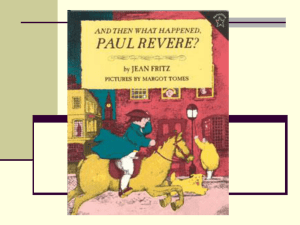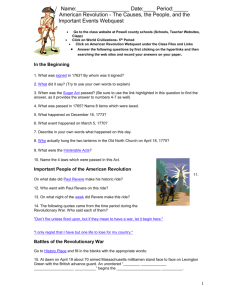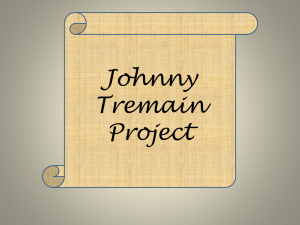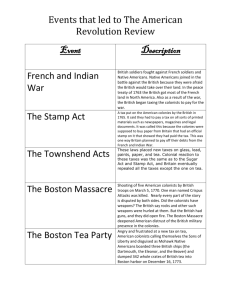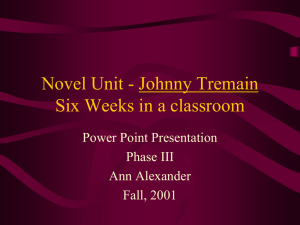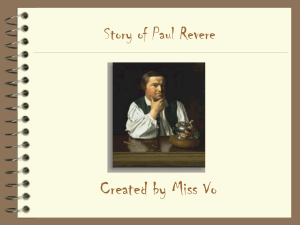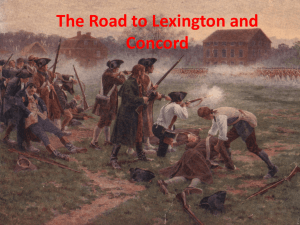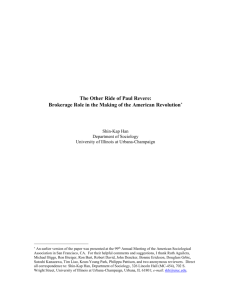Karen Easton
advertisement
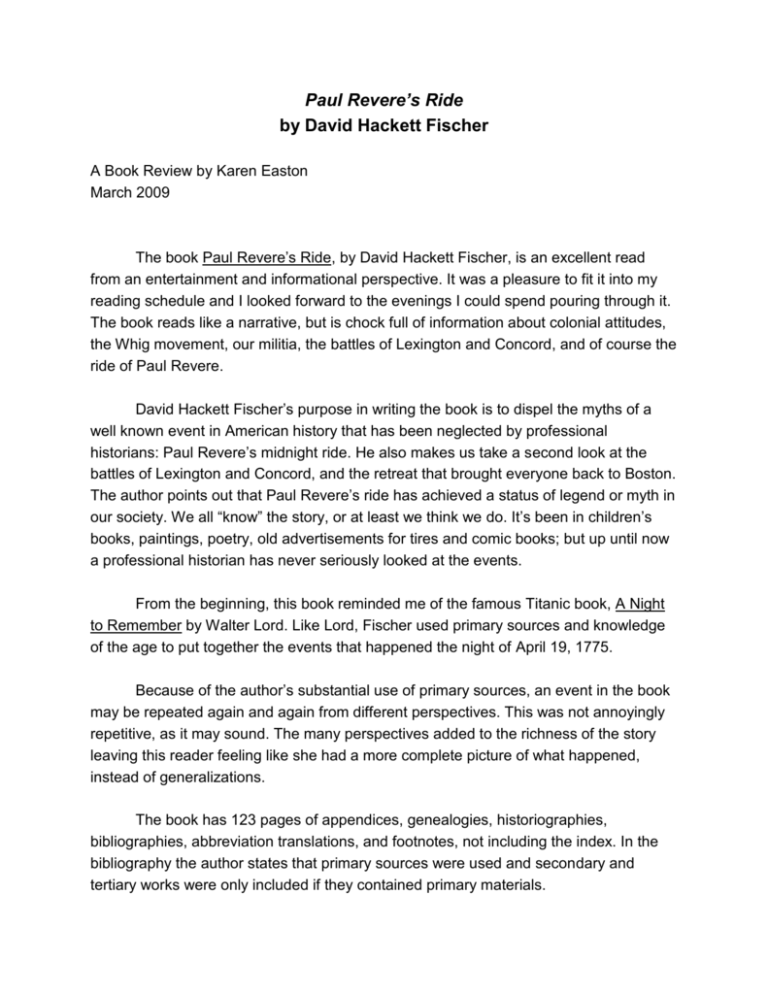
Paul Revere’s Ride by David Hackett Fischer A Book Review by Karen Easton March 2009 The book Paul Revere’s Ride, by David Hackett Fischer, is an excellent read from an entertainment and informational perspective. It was a pleasure to fit it into my reading schedule and I looked forward to the evenings I could spend pouring through it. The book reads like a narrative, but is chock full of information about colonial attitudes, the Whig movement, our militia, the battles of Lexington and Concord, and of course the ride of Paul Revere. David Hackett Fischer’s purpose in writing the book is to dispel the myths of a well known event in American history that has been neglected by professional historians: Paul Revere’s midnight ride. He also makes us take a second look at the battles of Lexington and Concord, and the retreat that brought everyone back to Boston. The author points out that Paul Revere’s ride has achieved a status of legend or myth in our society. We all “know” the story, or at least we think we do. It’s been in children’s books, paintings, poetry, old advertisements for tires and comic books; but up until now a professional historian has never seriously looked at the events. From the beginning, this book reminded me of the famous Titanic book, A Night to Remember by Walter Lord. Like Lord, Fischer used primary sources and knowledge of the age to put together the events that happened the night of April 19, 1775. Because of the author’s substantial use of primary sources, an event in the book may be repeated again and again from different perspectives. This was not annoyingly repetitive, as it may sound. The many perspectives added to the richness of the story leaving this reader feeling like she had a more complete picture of what happened, instead of generalizations. The book has 123 pages of appendices, genealogies, historiographies, bibliographies, abbreviation translations, and footnotes, not including the index. In the bibliography the author states that primary sources were used and secondary and tertiary works were only included if they contained primary materials. Throughout the book Fischer compares his study to that of other historians, pointing out that the other historians could be right, if the incident were looked at in isolation, but knowing what happened prior to and after these events help us see a bigger picture. One example of this that comes to mind is that of the town of Waltham, who failed to raise the alarm. Other historians have guessed that this town was filled with Tories. Fischer dug deeper, and while it is still unclear as to why they failed to show at Lexington or Concord, it is clear that it wasn’t because they were a town of loyalists; many men from Waltham joined the militia and subsequent Continental Army. The book is part biography, part social history, and part military history- a nice mix of actual events and the causes behind them. It is arranged in a semi-topical, semichronological order. Its chapters hopped from British to American lines; sometimes events would back up and start again under a different perspective. This chapter organization made it easy to keep track of information. Besides text, it included many maps, black and white pictures of paintings and woodcuts, song lyrics, sheet music, hand written letters, and 19th century photographs of landscapes that would be unrecognizable today. It was nice to have a small visual to go along with written descriptions of the people, and I found myself flipping back to look at a map or a photograph. About halfway through I noticed that each page had a two to five word description of what was written on that page. I didn’t notice it initially because it was placed where the title of the book and/or chapter typically goes. Looking back I could see how it would be useful if one were using this book as a resource. The introductions of Paul Revere and Lieutenant-General Thomas Gage, commander in chief of the British forces in the new world, take up the first two chapters of the book. They go into such depth that they begin with the character’s parents and other forefathers. For Revere, Fischer paints a picture of a sixth generation, well-liked artisan gentleman. I enjoyed reading his interpretation of the John Singleton Copley painting featured on the front cover, and the description of Revere’s folk-speech, as interpreted by his, and his friends’, writings. By the end of the first chapter I could picture Revere move and hear and him speak. Through these characters we are also introduced to the cultural differences between Americans and English at this time. The American fight included ideals of independence, liberty, and freedom. Sources from the British side of the war focused on where, how, and with what they will fight, with no “higher cause” being mentioned. Another difference was that the British military had a strict hierarchy that sometimes broke down during the events in this book, while America’s rebels, and the patriot movement itself, had no central authority figure; they had “many leaders, no commanders.” Fischer does a good job of pointing out that the two sides inherently did not understand each other, and explains perspectives that may be hard to wrap our 21st century brains around. After introductions are made, and we are given much background knowledge of that time and place, we are eventually led, with astounding detail, through the colonial countryside, first out to warn others, then on a military march, then as a prisoner, then in the thick of a battle and a retreat. A frequent misconception about the midnight ride is that Paul Revere was one lone rider galloping across the countryside. Fischer dispels this myth with countless accounts of two riders leaving Boston and others branching off after Revere passed their town. Included in the book is a map of the area showing the routes different riders took. The title of the book is a little misleading. This book is not just about Paul Revere’s ride. It’s also about a skirmish that turned into the first battles of a revolution. Another common misconception is about the Massachusetts militia. Sometimes simplified histories make it sound like they didn’t exist until the night of April 19th and inexperienced men managed to beat professional soldiers. In reality the militia was prepared well in advance, and had a plan for organizing quickly and going out prepared for combat. It seems extraordinary to us, but it was downright common at the time. I appreciated the fact that uncommon phrases, attitudes, or occurrences were explained, so that any reader who is not a history expert comes away from the book with more understanding and less confusion. The writing itself is not burdened by the intelligence of the writer, and it does not feel dumbed-down for a wider audience either. It’s a good mix of complicated language and complicated situations, followed by explanations. Stories were told from the perspectives of townspeople, soldiers of every rank, militia, tavern owners, impromptu volunteers, young and old, and men women and children alike. Occasionally there were seemingly solitary events, which were given more details, or were continued much later in the book. A tar and feathering that happened in Boston at the beginning of the book was mentioned again at the end of the book, when we found out that the victim had survived and was part of the militia on the road back to Boston, attacking the very regiment that had attacked him. This was a neat effect that made me feel like loose ends were being tied up. A particularly haunting chapter talked of the fear that swept the countryside after the men in the militia marched out of town. With only the very young, the very old, and women left in town anxiety filled the air. There was fear of being left defenseless, and fear that loved ones would never be seen again. Some towns panicked while others held tight; one even elected a leader, formed its own town defense and stopped people in the road, detaining them if they were Tories. Even though the book is titled Paul Revere’s Ride we lose Revere for a few days after the shot at Lexington. I did notice that even when he wasn’t physically present the author was able to pull him back in. After no sleep for two nights the British soldiers are still in the thick of battle, and we imagine Paul Revere asleep in a hayloft or beside a fire in a tavern. The British retreat back to Boston along the exact path that Revere took to warn the countryside of their arrival. To draw closure the last chapter of the book tells us the fate of major and minor participants. Many died at Bunker Hill, many lived through the Revolution, and some such as Paul Revere lived to a ripe old age. Fischer again brings us back to the present by stating that Paul Revere’s path is now a national park, and every April 19 th the “old memory is carefully renewed” by the ringing of town bells and a midnight rider. Those town bells that were cast by Paul Revere 200 years ago are still being used. I realize that most of the places mentioned are long gone, and the Massachusetts countryside would be unrecognizable to our Yankee forefathers, but while reading I constantly wrote down the names of places I would like to try and find. Fischer did an excellent job of informing his readers that town “x” is now known as the Boston suburb of “y,” and road “a” is now called highway ”b.” Fischer also did an excellent job at making connections between these events and the world we live in today, something I strive to do in my own teaching. He points out how the people of New England have fought bravely in every war, even though their ancestors were Puritan pacifists. A couple times he mentioned the universal phenomenon of how in the thick of things, everything starts happening in slow motion. He also compared our attitudes to those of our Revolutionary forefathers, and the fact that they thought of their forefathers and posterity when reflecting upon their actions. They were well aware that they would be in the ground someday and we would be thinking of their actions and their opinions, something I think many modern people do not reflect upon. I highly recommend Paul Revere’s Ride to anyone who wants to learn more about the big events in this book: the midnight ride, Lexington, Concord. I would also recommend this book to anyone wanting to do a cultural study of the habits and attitudes of 1775 Bostonians and their neighbors.

